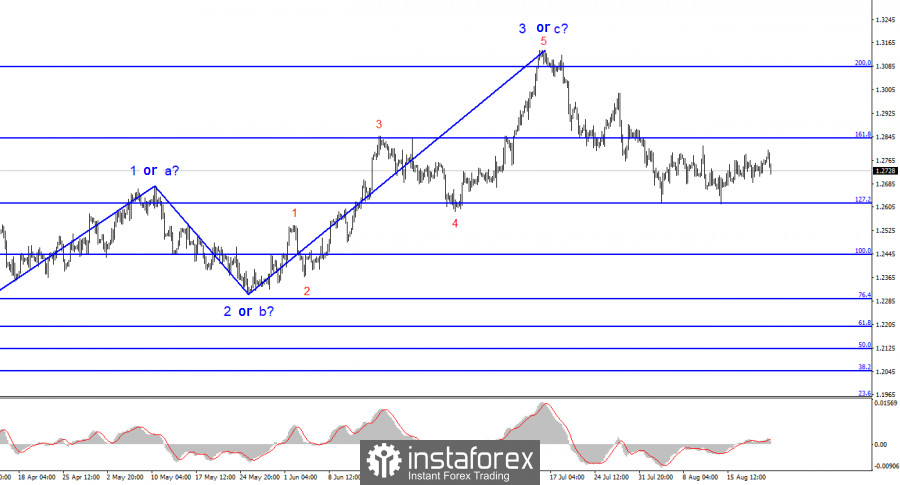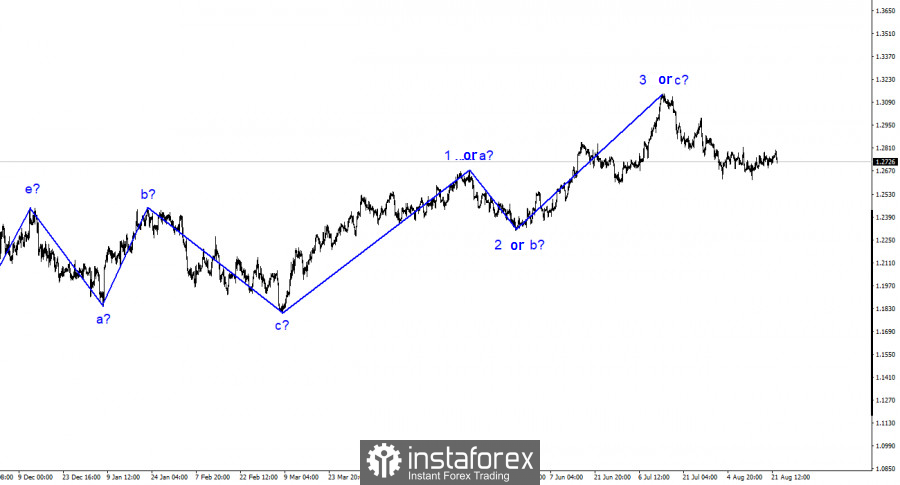
The wave analysis for the GBP/USD instrument remains fairly simple and clear. The construction of an upward wave 3 or c is completed, and the presumed construction of a new downward trend segment has begun, which could still be wave d. The British pound has no reason to resume the upward movement. However, the wave pattern has transformed into a more complex one, and wave 3 or c has taken a more extended form than many analysts expected several months ago. The entire upward trend segment may still take on a five-wave form if the market finds new reasons for long-term purchases.
In any case, the construction of the descending wave will continue, which began almost exactly on schedule. If the current wave receives a five-wave internal structure, it can be considered the first impulse wave and we can expect further declines in the pound (after the construction of the corrective wave 2 or b). However, there have already been two unsuccessful attempts to break through the 127.2% Fibonacci level, and the recent decline in quotes may also be the fifth wave in 1 or a, and internal within the corrective ascending wave of a larger scale.
Demand for the pound is too weak
The GBP/USD exchange rate fell by only 25 basis points on Tuesday, but the British Pound lost much more from the day's highs. Such a sharp and unexpected retreat from the achieved highs only indicates that sellers have begun to act again. If this is indeed the case, the instrument will fall back to the 1.2618 mark in the coming days, and the third attempt to break it may already be successful. And this will open the way for the instrument even lower to the 1.2442 mark, equivalent to 100.0% by Fibonacci.
There is no need for news to sell the pound and buy the US currency now. The pound sterling has risen against the dollar for almost a year, so even a simple correction scenario implies a fall in the instrument. And for a correction, even a news background is not needed, the market is simply fixing profits on long positions, accumulating for a whole year. Based on this, only some news this week can stop sellers or buyers from closing long positions.
Today there was no significant news in the UK; there was a report on housing market sales in the US. Volumes in July dropped significantly (by 2.2% m/m), but this had no negative impact on the dollar. As I mentioned earlier, the US currency can grow without strong data. Based on this, tomorrow's reports on business activity in the USA and the UK should not prevent the further strengthening of the American currency.
General conclusions
The wave pattern of the GBP/USD instrument suggests a decline within the downward trend segment. There is a risk of completing the current downward wave if it is wave d and not wave 1. In this case, the construction of wave 5 may begin from the current levels. However, we are now witnessing the construction of the first wave as part of a new downward trend segment. If this happens, the instrument will not rise much above the 1.2840 mark, and a new downward wave will begin. We are preparing for new sales.
The picture is similar to the EUR/USD instrument on the larger wave scale, but some differences remain. The downward corrective trend segment is complete, and the construction of a new upward segment is ongoing, which may already be completed or may take on a full-fledged five-wave form.






















